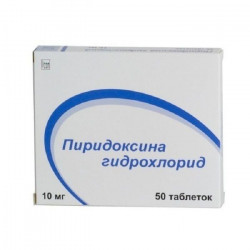



 All payments are encrypted via SSL
All payments are encrypted via SSL
 Full Refund if you haven't received your order
Full Refund if you haven't received your order
hydrochloride injection solution:
1 vial (1 ml) contains Pyridoxine hydrochloride 10 or 50 mg; water for injection up to 1 ml;
10 ampoules on 1 ml in a box.
pills:
1 pill contains pyridoxine hydrochloride 2, 5 or 10 mg;
in the bank 50 pcs.
Pyridoxine Hydrochloride - Vitamin B6. Phosphorylated and in the form of pyridoxal phosphate is part of the enzymes catalyzing decarboxylation and transamination. It plays an important role in the metabolism of tryptophan, glutamic acid, cysteine, methionine, as well as in the transport of amino acids across the cell membrane. Required for the activation of phosphorylase, for the formation of neurotransmitters, gamma-aminobutyric acid, Glycine, serotonin. Participates in the exchange of vitamin B12, folic acid, in the synthesis of porphyrins, in the exchange of unsaturated fatty acids. It is used to activate metabolic processes in myofibrils, especially during myocardial hypoxia. The daily need for adults is 2–2,5 mg, for children from 6 months to 1 year - 0.5 mg, 1–1.5 years - 0.9 mg, 1.5–2 years - 1 mg, 3– 4 years - 1.3 mg, 5–6 years - 1.4 mg, 7–10 years - 1.7 mg, 11–13 years - 2 mg, for boys of 14–17 years - 2.2 mg, for girls 14-17 years old - 1.9 mg.
B6hypovitaminosis, toxemia of pregnant women, sideroblastic anemia, leukopenia, CNS diseases (parkinsonism, small chorea, Littl's disease, radiculitis, neuritis, neuralgia, Meniere's disease), sea and airborne diseases, atherosclerosis, diabetic diabetes, seborrhea-like and non-seborrhea, airborne diseases, atherosclerosis, non-cerebral neurosis, seborrhea-like disease, atherosclerosis, non-seborrhea, seborrhea-like, neuritis, neuritis, neurology neurodermatitis, psoriasis, exudative diathesis, use of isoniazid preparations.
Hypersensitivity.
Inside, after eating.
For the prevention of B6-hypovitaminosis prescribed to adults for 0,002 - 0,005 g per day, children - for 0,002 g per day.
Therapeutic doses for oral administration are for adults 0.02 - 0.03 g 1 - 2 times a day; for children, reduce the dose according to age. The course of treatment is 1 - 2 months.
Subcutaneously, intramuscularly and intravenously.
Adults are usually prescribed at 0.05-0.1 g per day in 1-2 doses, for children at 0.02 g. The course of treatment for adults is 1 month, for children 2 weeks.
For the treatment of sideroblastic anemia - 0.1 g intramuscularly 2 times a week. It is advisable to simultaneously take folic acid, cyanocobalamin, riboflavin.
When parkinsonism - 2 ml of 5% solution per day intramuscularly. The course of treatment is 20-25 injections. After 2-3 months, the course is repeated.
With depressions of involutional age administered intramuscularly at 0.2 g per day.
Peptic ulcer and duodenal ulcer.
Allergic reactions, increased acidity of gastric juice.
The effect of reducing isoniazid, cycloserine, penicillamine. Pharmaceutical incompatible with B Vitamins 1 and B12. Weakens anti-parkinsonian activity of levodopa.
List B. In the dark spot.
Pyridoxine hydrochloride